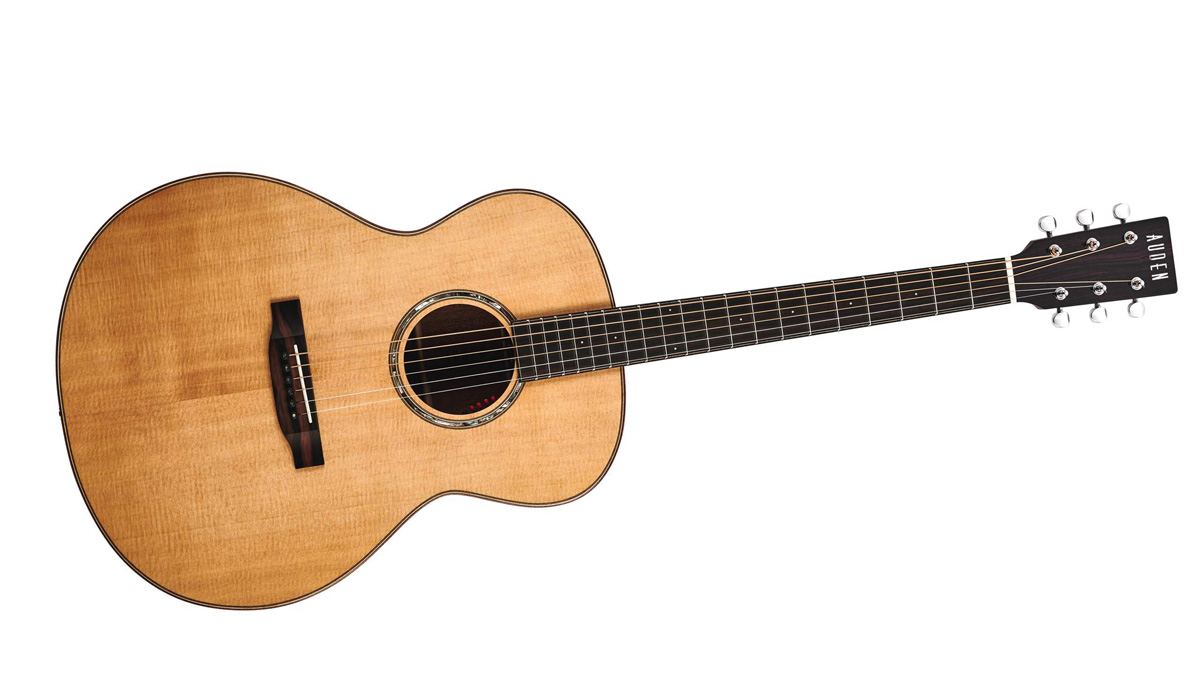MusicRadar Verdict
No question this is a fine guitar, and well priced.
Pros
- +
Sweet, balanced tone makes it a great all-rounder that’s still a bit different.
- +
Strong pickup system.
- +
Great spec and build at this price.
Cons
- -
Nothing really - it’s a lot of guitar for the money.
MusicRadar's got your back
One of the few Guitarist Gold awards we handed out last year went to Auden’s cracking Austin 12-string acoustic, so it was with a keen sense of anticipation that we took delivery of the six-string version - the Austin Artist.
It is made with Auden’s hybrid build process, in which the woodwork is done in a small nine-luthier workshop in China, but the final neck-set, finishing and setup is completed at Auden’s HQ here in the UK at Higham Ferrers in Northampton.
You wouldn’t necessarily notice straight away that the Austin we have in our hands now is almost the same guitar as the 12-string we tested last year. The latter’s stealthy ‘smokehouse’ finish is replaced here by a more conventional spruce top look with opulent appointments.
“It’s the posh version,” comments Auden founder Doug Sparkes. “It’s got a new mother-of-pearl headstock logo, solid mahogany back and sides, triple-A grade spruce top, plus an African mahogany neck with an ebony faceplate on the headstock.”
It’s still pretty much the same 14-frets-to-the-body design as the 12-string Austin, however, with an hourglass outline that falls somewhere between a (very) round- shouldered dreadnought and an OM, though Doug says that the “bout of the Artist was extended slightly, so we could get the bracing a bit further down inside to help with bottom-end response”, adding that “it also has the wonderful Brad Clark Supernatural pickup system”.
We’ll come back to that pickup system in a bit as it’s exclusive to Auden in the UK and the company think it’s a game-changer.
Sounds
And so onto the sounds. We begin with a little fingerpicking and are rewarded with a honey-sweet yet articulate voice that sets the tone for what this guitar is all about. The foundation of its voice is a supple, mellow midrange that has abundant warmth but great definition, too. The Austin has less ‘woof ’ than a dreadnought but more bass than many OMs, and striking a few hard chords shows that the sweetness and balance don’t collapse when you push the guitar, either - the projection and clarity is excellent and if you’re looking for a different take on what a great ‘all-rounder’ acoustic guitar can be, you should try this.
Want all the hottest music and gear news, reviews, deals, features and more, direct to your inbox? Sign up here.
Now to the Supernatural pickup system. This is a new system developed by Bradley Clark who is the ‘Clark’ part of noted Australian guitar maker Cole Clark. Clark’s research suggested that a standard under-saddle piezo ribbon was prone to vibration that caused fizzy midrange and loss of clarity. Clark’s solution was a new system that gives each string its own piezo ‘polepiece’ and “listens to the under-saddle [area] but also the soundboard”. Fitting the Supernatural pickup is a more serious luthiery operation than with a standard piezo, so it’s only available ready-fitted on Auden’s guitars.
The Supernatural pickup is controlled via a proprietary preamp just inside the soundhole, which has three EQ sliders for bass, mid and treble; a Total Volume slider; and a mode button. The latter cycles through four EQ presets that Auden says are “tuned” to different playing styles that Doug defines as “thick strum”, “finger-pick”, “solo” and “thin strum”. You cycle between presets by pushing the button, which flashes once for Preset 1, twice for 2 and so on. It’s not hugely intuitive, but simple enough once you know the drill. Moving the sliders overrides the currently selected preset. Intrigued, we plug in the Austin first. Using an AER Compact 60 combo, we soon discover that the presets offer useful ‘speed dial’ EQ settings, though Auden’s idea of what each preset is best for doesn’t necessarily match our own preferences.
For example, we liked the ‘Thin Strum’ setting on the Austin for fingerstyle. No matter, that’s up to the individual and you can adjust EQ to taste with the sliders anyway. More importantly, the core sound does indeed seem to offer something fresh - a subtle but palpable increase in space and air around each note and a more natural voicing through the amp.
Jamie Dickson is Editor-in-Chief of Guitarist magazine, Britain's best-selling and longest-running monthly for guitar players. He started his career at the Daily Telegraph in London, where his first assignment was interviewing blue-eyed soul legend Robert Palmer, going on to become a full-time author on music, writing for benchmark references such as 1001 Albums You Must Hear Before You Die and Dorling Kindersley's How To Play Guitar Step By Step. He joined Guitarist in 2011 and since then it has been his privilege to interview everyone from B.B. King to St. Vincent for Guitarist's readers, while sharing insights into scores of historic guitars, from Rory Gallagher's '61 Strat to the first Martin D-28 ever made.

